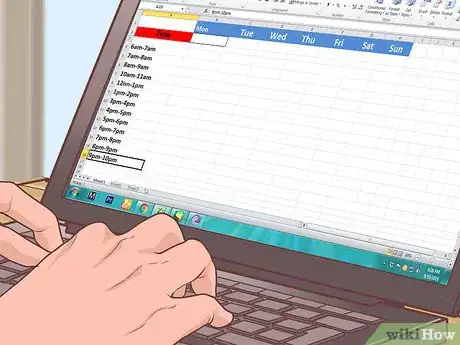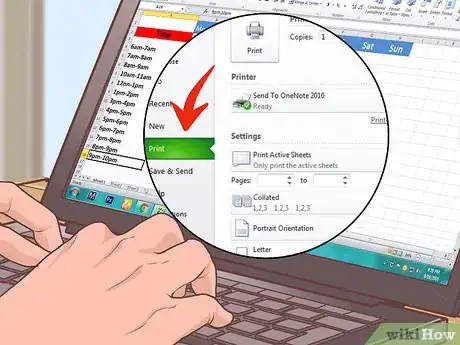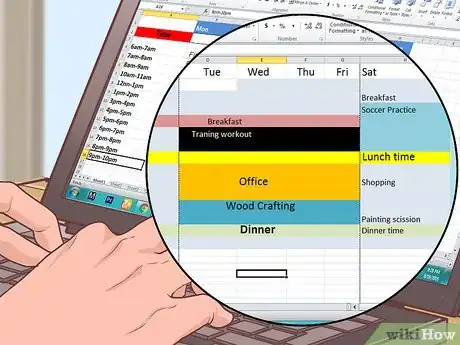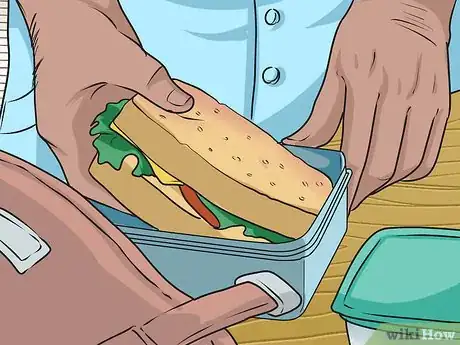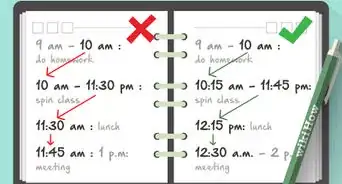This article was co-authored by Alexander Ruiz, M.Ed.. Alexander Ruiz is an Educational Consultant and the Educational Director of Link Educational Institute, a tutoring business based in Claremont, California that provides customizable educational plans, subject and test prep tutoring, and college application consulting. With over a decade and a half of experience in the education industry, Alexander coaches students to increase their self-awareness and emotional intelligence while achieving skills and the goal of achieving skills and higher education. He holds a BA in Psychology from Florida International University and an MA in Education from Georgia Southern University.
wikiHow marks an article as reader-approved once it receives enough positive feedback. This article has 19 testimonials from our readers, earning it our reader-approved status.
This article has been viewed 622,839 times.
With the hectic lifestyle that the majority of people lead these days, it’s important to know how to schedule your time well. Time is the one resource that can’t be bought yet many, at one time or another, either use it ineffectively or waste it. A well thought-out timetable basically helps you take control of your day from one hour to the next. It’s also a great way to help you achieve the goals you have in life, both big and small.
Steps
Writing Down Your Most Important Daily Tasks
-
1Prepare a list of what you need to do on a daily basis. Don’t worry if it’s organized or not. This is only about brainstorming, not a to-do list. Take an hour or so, and jot down everything you have to do each day (and everything you don’t do but should be doing).[1]
- If it’s difficult to think of everything, carry around a small notebook, and write down your activities throughout the day.
-
2Write down the big tasks and the little ones. When you first start, no activity is considered too small. If it’s something you need to do, it’s something you need to do. When you’re creating a timetable for the first time, it’s better to put everything in and edit it later, if need be.[2]
- If you have to walk your dog in the morning and evening, then jot that down.
Advertisement -
3Ask yourself questions related to your activities. What tasks do you need to do to make sure you eat well? Which tasks do you need to complete each day in order to get to work? What do you need to do to make sure your daughter is picked up from school?
- You’ll probably be surprised at how many small tasks need to be taken care of in order to achieve your bigger responsibilities. But there is light at the end of the tunnel. A timetable will help you to identify areas where you’re not getting much back in return and that you can work on eliminating.
-
4Analyze your list. If you find that you have little or no discretionary time available, re-evaluate the tasks to see if they are absolutely necessary. You may find that some responsibilities can be tackled in a more efficient way or delegated.
- Ask yourself what tasks or activities are a top priority, and then make sure those items are included in your timetable.
- If you find yourself at the stove more often than you’d like, think about asking a neighbor if he or she wants to share cooking duties. The two of you figure out a few dishes you both like and then trade in cooking them one or two days a week.
Making the Timetable
-
1Open Microsoft Excel or a similar spreadsheet program. Make a column of times on the left side of the page and a row of days of the week at the top.
-
2Match up your tasks with times and dates. Label the top column of your spreadsheet with the days of the week. Then, label the left side of the spreadsheet in hour intervals. Slot your tasks into the spreadsheet based on when you have to do them. You can even color code them based on importance or the type of activity.
- Put rest or break periods into your schedule, so you have time to unwind on busy days.
- Aim to organize your timetable in larger increments of time, as hourly time frames are easier to schedule. But don't be afraid to put 30 minute tasks in as well.[3]
-
3Keep it flexible. It's difficult to predict how long each activity will take. So make sure your schedule can bend easily in one direction or another when need be. You also want to factor in a small buffer of time for unexpected delays.[4]
- Also, don't fall into the trap of using your relaxation time as a "buffer" zone. Relaxation time should not be seen as a luxury; it should be treated as important as any other activity.
-
4Print out your spreadsheet. It is generally helpful to print multiple copies -- put one on your refrigerator, one in your bedroom and one in the bathroom. Underline or highlight important activities.
-
5Color code different areas. Use a different color marker for the separate areas in your life. You could use yellow for work, red for exercise, blue for school and so on. This way you’ll get a good sense of how your day is planned just by glancing at it. If there’s a lot of blue, for instance, you’ll know that you’re overloaded with school right now.
Optimizing Your Timetable
-
1Assess how much energy you have in the morning. Most people’s critical thinking skills and creativity are strongest in the morning. However, they tend to decrease as the day progresses. If this is how you are, then schedule your “big thinking” activities, like writing, for instance, in the morning.[5]
- However, maybe you do your most creative work at night. Neither time is wrong. It’s all about coming up with an effective timetable that suits you and your needs.
-
2Assess how much energy you have in the afternoon. If you’re like most, your energy has dissipated somewhat by the afternoon. If so, then this is a good time to do more boring, routine tasks. Things you don’t have to think much about basically. Think about spending this time of day for setting appointments, running errands, answering brief emails, etc.
-
3Assess how much energy you have in the evening. For many, evenings are good for planning and preparing for the next day. Your “get ready” tasks might include packing lunches, laying out your clothes, and spending time straightening up and de-cluttering.
-
4Begin forming the habits you need in order to accomplish your goals. Choose to spend 30 minutes a day on writing that novel, organizing your garage or learning how to garden. Moving a little towards your goal each day will help you in developing the good habits to maintain it. This is because you’ll be on autopilot. Essentially anything you do on a regular basis, good or bad, eventually becomes a habit.[6]
-
5Experiment with the timetable. How does it feel? Did you schedule your activities at times that made sense? Do you need to adjust things? Change anything that is not working on a case-by-case basis. You don’t have to wait until the end of the week or month. Adjust little by little every few days until it feels workable to you. You will also need to probably make big and small changes to it every month, as the only thing that’s certain in life is change.
Community Q&A
-
QuestionCan you advise me which subject should I study first and which later?
 Tom De BackerTop AnswererThe order of the exams is a key determining factor here. No point in studying for an exam that's in two weeks if you have one tomorrow. However, your perception of how difficult the subjects are is also very important. Work through the most difficult ones first. Don't postpone, just start doing it now; it has to be done anyway, might as well get started.
Tom De BackerTop AnswererThe order of the exams is a key determining factor here. No point in studying for an exam that's in two weeks if you have one tomorrow. However, your perception of how difficult the subjects are is also very important. Work through the most difficult ones first. Don't postpone, just start doing it now; it has to be done anyway, might as well get started. -
QuestionMine is a simple trailer departure schedule. What is the best way to format, for making it printable into laminated copies for employees? I need it large enough to fill page but no larger, and to have "professional" appearance. Readable from couple feet away. It's only 20 rows, 3 columns. What can I do?
 Community AnswerMicrosoft Excel is the ideal program for providing a professional appearance. It's quite easy to use when you know the functionality. You can find tutorials on wikiHow or online (such as via YouTube).
Community AnswerMicrosoft Excel is the ideal program for providing a professional appearance. It's quite easy to use when you know the functionality. You can find tutorials on wikiHow or online (such as via YouTube). -
QuestionI always make timetable. but I just ignore it after some time. What can I do?
 Tom De BackerTop AnswererThat's very normal, we all do it. But it's also a sign that you've made the wrong timetable. Make a new one. Make a real one. Be honest with yourself. If you plan to go for a run every morning before you shower, but never actually do it, accept that that is perfectly fine; don't blame yourself, strike it from your planning and find a way to exercise that you can stick to and enjoy. It's just one example. If you're not sticking to your schedule, make a new one that you want to stick to and show a little discipline as well.
Tom De BackerTop AnswererThat's very normal, we all do it. But it's also a sign that you've made the wrong timetable. Make a new one. Make a real one. Be honest with yourself. If you plan to go for a run every morning before you shower, but never actually do it, accept that that is perfectly fine; don't blame yourself, strike it from your planning and find a way to exercise that you can stick to and enjoy. It's just one example. If you're not sticking to your schedule, make a new one that you want to stick to and show a little discipline as well.
References
- ↑ https://open.lib.umn.edu/collegesuccess/chapter/2-3-organizing-your-time/
- ↑ https://open.lib.umn.edu/collegesuccess/chapter/2-3-organizing-your-time/
- ↑ https://sass.queensu.ca/resources/online/time-management
- ↑ https://sass.queensu.ca/resources/online/time-management
- ↑ https://web.roguecc.edu/strategies-student-success/managing-time-success-college
- ↑ https://web.roguecc.edu/strategies-student-success/managing-time-success-college
About This Article
To make a timetable, start by making a list of everything you need to do on a daily basis, including small tasks like letting your dog out or eating breakfast. Then, create a spreadsheet in a program like Microsoft Excel, and input your list and the times you plan on doing everything at. Remember to schedule yourself breaks throughout the day, and make sure there's a small buffer of time in case of unexpected delays. You might also want to color code tasks into different categories, like work, relaxation, and exercise. To learn how to optimize your timetable and be more efficient, scroll down!





